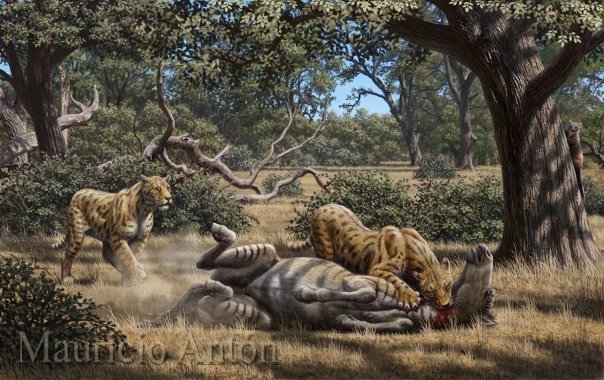Machairodus hunting an Hipparion: from Raw Sketches to Final Art
One of the many illustrations I prepared for the new exhibition about the Batallones fossil site shows the large sabertooth cat Machairodus aphanistus hunting a three-toed horse of the genus Hipparion.
I needed to illustrate the key moment of the killing bite, and as a result the predator and prey duo make a dramatic but not especially dynamic ensemble, with the horse being pinned to the ground by the weight of the predator. I had previously rendered this action as a pencil drawing on a white background, but this time I wanted to place the animals in their habitat, showing the kind of environment that allowed the sabertooth to creep on its prey taking advantage of cover. But how to create a dynamic environmental composition when the center of attention is at the same time violent and static? Placing the kill in the center of the frame would neutralize the composition, creating a sort of implosion where everything else becomes superfluous.
My first decision was thus to move the cat and horse, and especially their heads which would attract all attention, away from the frame’s center. This decision at the same time made the composition more dynamic and threw it out of balance so I included a second cat in the scene to put something on the empty left side. In my hypothetical story, the hunting cat would be an adult female, while this second individual would be a grown cub, of the kind that sometimes assist and sometimes ruin their mother’s kills. Such a scenario is derived from the behavior of modern big cats and it allowed me to make the presence of a second large cat compatible with the likely solitary life of these sabertooths.
In this first raw sketch I quickly outlined the masses of the three animals, and used several trees to organize the rest of the space in the frame. Looking at the draft I felt that the second cat had perhaps too much importance in this composition, how to solve this problem?

In this second pencil drawing I attempted to leave the second cat in shadow in order to center the attention on the kill, but even with such a quick sketch I noticed that there was enough intensity on the predation without further highlighting it. The second cat should retain its share of the sunlight

In this third sketch I calculated the effects of perspective more carefully and found that I could place the second cat at a distance where it would look conveniently smaller than the hunting cat. With the animals approximately placed in the composition I began to work in the digital painting

As the painting began to take shape I found that the trees were shaping the composition a bit too strongly. Drawn with a few light pencil strokes, they seemed to arrange the space conveniently, but when those lines became solid branches they almost appeared to be enveloping the animals, like the sinister “Old Man Willow” capturing the hobbits in The Lord of the Rings… So I trimmed the lower branches leaving some breathing space for the animals and creating a corridor for our eyes to look into the mid-distance. Other changes included to block the view of the distant hilltop (which resonated too much with the shapes of the animals and seemed also to compete for attention) and to replace the tree trunk in the left side foreground with a more modest shrub.
In the finished painting I added a marten-like mustelid climbing on the tree trunk on the right, an element that further dilutes the tension. All in all I tried to compensate the violence of the kill with an apparently matter-of fact distribution of the elements in the composition so it would not look overly dramatic

The random patterns of light and shadow on the ground also intend to treat the story’s “stars” almost as just two more objects placed in the landscape, like something you could see while driving along in your safari vehicle. I don’t claim that this anti-dramatic treatment is the best solution for this painting, but it is what my instincts dictated as I went along. Following your instincts is in no way an infallible recipe for success, but as an artist it is still the best compass you have for finding your way through the conflicts of a complex work!
Posted on 12/02/2018, in Uncategorized. Bookmark the permalink. 2 Comments.
thank you very much for showing what the process to get such a beautiful and balanced picture.
I also have a question about the coat of the hipparion, you used stripes on it, not as intense as on a zebra, but I see the use of zebralike striping often used when ancient and extinct equines a pictured.
Is there a particulair reason to connect striping with ancient features? Or is it just an artist convention?
Although I know that the American Equis stenonis had very zebralike features in its skeleton I am a favorite of the theory that zebra patters are a modern features originating in Africa where the Equus species were a late arrival as a response on tse-tse flies..
Thanks for your comments Peter. Zebra-like stripes on fossil equids are a speculative feature. The presence of a dorsal stripe, some leg striping and transverse shoulder stripes are widespread among extant horses and are often considered a primitive feature. But a bold zebra-like pattern is restricted to African zebras and may be a derived trait of those species, so I admit it would probably be more conservative to show fossil equids with wild-ass-like coats, but I often give them stripes because they look neat! Charles Knight and Zdenek Burian painted the earliest equids with horizontal stripes like those of young tapirs (or young wild boar) and that seems well thought to me, but for more advanced horses I suppose we must seek our models among extant equid species.